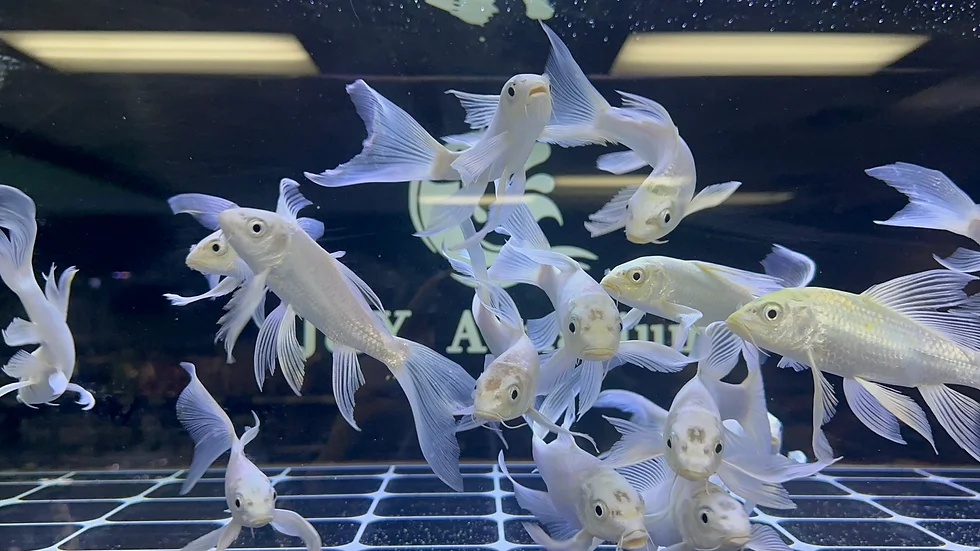Butterfly koi (also known as Goi Butterfly or Koi Butterfly) are an enchanting and increasingly popular breed of ornamental fish, particularly appreciated for their graceful movements and vibrant colors. These koi have longer, more elegant fins than traditional koi, resembling butterfly wings in motion. However, many potential koi enthusiasts wonder: Is butterfly koi easy to care for? In this article, we will explore the essential care requirements, maintenance tips, and overall ease of keeping butterfly koi as pets.

Butterfly koi, a variant of the traditional Japanese koi, are characterized by their long, flowing fins and vibrant color patterns. They were first developed by crossing regular koi with longfin varieties, resulting in a stunning, graceful fish that is a favorite in garden ponds and water features. The larger fins make them appear even more majestic as they swim, and their ability to adapt to various environments makes them a suitable choice for both beginners and experienced pond keepers.
These koi are typically vibrant shades of orange, red, yellow, and black, though their patterns and colors can vary greatly depending on the specific variety and genetics. They are often admired for their serene beauty and for their ability to coexist peacefully with other types of koi and pond fish.
Like all koi species, butterfly koi thrive in clean, well-oxygenated water. The water quality is one of the most critical factors in their care. To ensure a healthy environment for butterfly koi, the following conditions must be met:
Water temperature: Butterfly koi are best kept in water temperatures between 50°F and 75°F (10°C and 24°C). They are hardy fish, but temperatures outside this range can cause stress or illness.
Water pH: The ideal pH level for butterfly koi is between 7.0 and 8.0. A balanced pH ensures proper digestion and overall well-being.
Ammonia and nitrite levels: Keep ammonia and nitrite levels as close to zero as possible. High levels can be toxic to koi, leading to health issues or death.
Filtration: Butterfly koi produce a significant amount of waste, so investing in a high-quality filtration system is essential. Regular cleaning and maintenance of filters are crucial for preventing harmful toxins from building up in the pond.
Butterfly koi are large fish, and they require ample space to swim freely. The general guideline for pond size is:
Pond size: At least 1,000 gallons (3,785 liters) of water per adult koi fish. This ensures they have enough space to grow and swim comfortably.
Depth: A pond depth of 3 to 4 feet (90 to 120 cm) is recommended to give the koi enough room for movement and protection from predators.
Proper nutrition is a vital part of butterfly koi care. These fish are omnivorous and can be fed a variety of foods, including:
Koi pellets: High-quality koi pellets are designed to meet the nutritional needs of koi, offering the right balance of protein, fat, and vitamins.
Vegetables: Butterfly koi also enjoy leafy greens like lettuce, spinach, and peas. These vegetables provide essential fiber and nutrients.
Occasional treats: Treats like worms, shrimp, or fruit can be given occasionally to supplement their diet. However, be cautious not to overfeed, as excess food can lead to poor water quality.
Feeding should be done once or twice a day, but avoid overfeeding. Excess food not consumed by the koi will pollute the water and affect the pond's ecosystem.
While butterfly koi are generally hardy, they are still susceptible to a range of diseases, particularly if water quality is compromised. Some common health issues to watch out for include:
Ich (Ichthyophthirius multifiliis): A common parasite that causes white spots on the koi’s skin. This is often linked to poor water conditions or stress.
Koi herpesvirus (KHV): A serious viral infection that can lead to high mortality rates. Prevention is key, and keeping your koi in good water conditions with low stress can help reduce the risk.
To maintain good health, always monitor your koi for signs of illness, and perform regular water tests to ensure optimal conditions. If you notice any abnormalities in behavior or appearance, consult a vet specializing in aquatic life for advice.
Yes, butterfly koi do require special attention during the colder months. In areas where temperatures drop significantly, it's important to ensure that the pond doesn’t freeze completely. Butterfly koi can survive in temperatures as low as 50°F (10°C), but prolonged exposure to freezing temperatures can be harmful.
Pond heaters: If your pond is in a region with cold winters, consider installing a pond heater or de-icer to prevent the water from freezing completely.
Aeration: Aerating the water in winter ensures that the koi can continue to receive oxygen, even if the pond’s surface is frozen over.
Feeding in winter: Reduce feeding during the colder months, as koi’s metabolism slows down in lower temperatures. Stop feeding them if the water temperature drops below 50°F (10°C).
In conclusion, butterfly koi are relatively easy to care for, provided their basic needs for water quality, space, and nutrition are met. While they do require some maintenance, including regular water changes, proper filtration, and monitoring of health, they are a hardy species that can thrive in a well-maintained pond. Their graceful movement and vibrant colors make them a stunning addition to any water garden, and their relatively low-maintenance nature makes them suitable for both beginners and experienced fish keepers.
How to Build a Koi Pond: Step-by-Step Guide for Beginners
Top 5 Koi Diseases and How to Prevent Them
Best Pond Filters for Koi: Recommendations for a Healthy Pond
By ensuring the right environment and following these care guidelines, you’ll enjoy a vibrant and thriving butterfly koi population in your pond for years to come.
animal tags: butterfly-koi
We created this article in conjunction with AI technology, then made sure it was fact-checked and edited by a Animals Top editor.